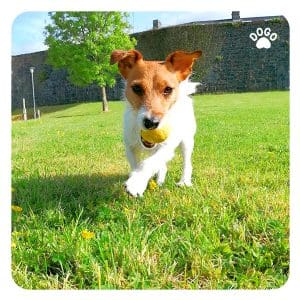
When a dog is overly energetic a lot of the time, they need more mental stimulation. This plan should be followed to help tire your energetic dog out mentally. We will introduce shaping into your training routine.
Shaping
Shaping can be used to form almost any behavior or action and makes your dog think for themselves. This is great for teaching independence and also tiring them out as it takes a lot of mental energy.
Shaping can also be used to correct unwanted behavior in dogs. For instance, if your dog has a habit of barking excessively, you can use shaping to teach them to be quiet on command. Start by rewarding your dog for being quiet for a few seconds, then gradually increase the time they need to be quiet before they are rewarded. With patience and consistency, you can shape your dog’s behavior to be more desirable. It is important to note that shaping should always be done in a positive and reward-based manner. Punishing or scolding your dog during the shaping process can cause them to become fearful or anxious, which can lead to behavioral issues. Therefore, always use positive reinforcement and praise to shape your dog’s behavior.
A good example of shaping is teaching a dog to bring you an item. Normally, when teaching puppies we use a dumbbell so I will use this as an example.
Place the dumbbell on the ground and stand away from it, act as boring as possible. The whole point of this exercise is the dog has to think for themself and discover they can interact with the environment to get rewards.
If your dog looks in the general direction of the dumbbell – click and treat. Throw the treat to the dog so they aren’t too focused on you. Continue this for a few repetitions. Your dog should start to make the connection, if they start looking in the direction of the dumbbell right away, wait. This is the next step, we use the dogs’ own frustration to make them try new things. The dog should get slightly confused and frustrated with no reward for behavior that got them rewards before. They will naturally make a more enthusiastic movement. Hopefully looking directly at the dumbbell or even stepping towards it, you then click and reward heavily, making a big fuss on how proud you are.
Since this is such tiring work, end the session here on a good note. Perform a few known tricks and take a rest.
Second session

Continue this, doing a few repetitions of our latest advancement then moving to the next step. This could be something as small as the dog moving towards the dumbbell or as big as them running up and picking it right up. Some dogs need very slow and small steps and some will realize pretty quickly the dumbbell means good things.
Once you have the dog interacting with the dumbbell then break it down into very small steps. If they are nudging the edge of the dumbbell but you want them picking it up from the center, wait until their nose goes over the center and click then treat. Do this until the dog is going right for the center.
It is very important at this stage to be accurate when you click.
Once the dog clearly understands their nose should be in the center, wait for frustration. If they even open their mouth a little bit click and reward. The general idea is you slowly work them up to grabbing the dumbbell in their mouth and only grabbing it where you want.
Teach to retrieve
You would then work on getting them to bring it to you. This can be taught by either calling them to you and hoping they bring the dumbbell. If they only bring a few steps click and treat and slowly increase the distance they have to walk towards you. You can also do this by holding your hand under the toy and telling them to drop it and making your hand the target, then slowly moving your hand away.

This gives you the basic idea of shaping -you pretty much link behaviours with objects until the dog understands what the target is and slowly understands how to interact with it. It can be used for so many different mentally stimulating behaviours.
It isn’t very easy to accomplish due to having to move slowly and use so many small steps. However, it is a great mental exercise that will definitely tire your dog.
It is also important to note that not all dogs are created equal. Just like humans, dogs have different energy levels and exercise needs. Some dogs may require more or less exercise than others. Therefore, it is essential to monitor your dog’s behavior and adjust their exercise routine accordingly. It is also important to keep in mind that physical activities should be adapted to the dog’s age and physical condition. For instance, a senior dog may need a less strenuous exercise routine than a young and energetic dog. Therefore, before starting any exercise program, consult with your veterinarian to ensure that your dog is healthy enough for physical activity.






